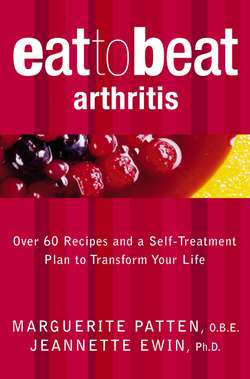Читать книгу Arthritis: Over 60 Recipes and a Self-Treatment Plan to Transform Your Life - Marguerite O.B.E. Patten - Страница 11
Enjoy gentle exercise
ОглавлениеMany of the causes of joint and muscle pain and discomfort should be eliminated or reduced by following the Eat to Beat Arthritis Diet. However, you also need to keep active to keep your body at its best, especially if you need to lose weight.
The choice of exercise activities is rich and varied. All you need to do is choose one and give it a try. If your first choice does not suit you, try another, and another, until you find one that you enjoy. Add at least three exercise sessions to your weekly routine. Include gentle stretching at both the start and conclusion of each session. No matter how old or unfit you are, visit the local gym and see if they offer anything that would interest you. Alternatively, contact local community and church groups to see if they offer activities that would get your blood pumping. You’ll be surprised by the variety of activities available. For example, line dancing seems to be all the rage for every age these days, and some of the less strenuous martial arts both strengthen the body and calm the mind.
Remember, talk with your doctor before beginning any new exercise or sporting activity. He or she will probably applaud your decision to get out and get moving.
Good forms of exercise include walking, swimming and stretching. Gardening is also valuable exercise as it promotes joint health by stretching and placing gentle pressure on muscles surrounding joints in the arms, legs, hips and back.
Pain may be increased when you first start exercising, but you will soon ‘work through’ that as your stiff joints regain their flexibility. Exercise unlocks stiff joints and tissues. How many times have you heard someone say, ‘I was so stiff this morning I thought I wouldn’t be able to get out of bed; but once I got moving everything was fine.’ You have probably had this same experience, and know that movement is a large part of keeping stiff limbs and muscles active.
To conquer the pain of arthritis, you should gently and repeatedly move the joints and tissues that hurt. By doing so, you strengthen the muscles that support the tissues, stimulate normal bone growth, and stimulate the circulation to the inflamed area. Remember, if you reduce your level of daily activity because you are afraid of the pain and discomfort that accompanies movement, you are going to lose more muscle strength and fail to stimulate normal bone growth.
Yoga and Pilates are two excellent exercise disciplines. Both stretch and strengthen muscles, but in their elementary forms neither one pushes or pulls muscles into extreme positions or activity. As relaxation is a principal goal in the practice of yoga, it has special value for arthritis sufferers. Yoga originated in India about three thousand years ago, and is based on physical control and relaxation. The practice has become increasingly popular over the past several decades, and many forms of movement and self-training have evolved. To learn more about yoga, visit your local library for books on the subject. Also, shop around to see what programmes are available in your area. Yoga is often offered in community and adult education centres.
Pilates is a form of exercise and body control developed by Joseph Pilates in the early 1900s. Born in Germany in 1880, Pilates was sickly and frail as a child, and as a result became obsessed by physical fitness. By the time the Great War broke out in Europe, Pilates was in England, teaching detectives self-defence. As a German, he was interned for the duration of the conflict. While in the camp he devised a regime of exercises for his fellow internees that maintained their health and fitness level while they were held in confinement. Not one of these people died during the influenza outbreak of 1918, and Pilates often claimed this was due to the exercise programme he developed. (There may be some truth in this, as we now know that exercise strengthens the immune system.)
After the war Joseph Pilates returned to Germany and began working with dancers and others who sought perfection in body form, flexibility and balance. When asked to begin work with the German army, Pilates refused and fled to America. On the boat he met a nursery teacher whom he later married. Together they established a fitness studio in New York, where dancers, athletes and members of top society soon became his clients. His devoted followers have included Martha Graham, Gregory Peck, Katharine Hepburn, Jodie Foster, Michael Crawford, Joan Collins and Sigourney Weaver. Tennis professional Pat Cash and world champion ice skating star Kristi Yamaguchi are among the athletes who have profited from Joseph Pilates’ teaching. His methods are now taught around the world.
The Pilates method differs from other fitness programmes in the way the exercises are approached. Like yoga, it binds the activities of the mind with those of the body, making the mental perception of the body as important as physical movement. As in yoga, the three main elements of each exercise are relaxation, control and co-ordination. Pilates differs from yoga in one important way, however: the Girdle of Strength, that is the internal cage of muscles that supports and holds the body’s internal organs in place, is tightened and used in every exercise practised. So too are the multifidous muscles, which stabilize the lumbar spine. By building power and flexibility into these often overlooked muscle groups, Pilates uniquely contributes to the physical fitness of sufferers of innumerable physical ailments and injuries.
For more about Pilates and how it can help you, browse in your local library and bookshop for more information. Also contact community and fitness centres to see what they have to offer in the way of basic courses.
